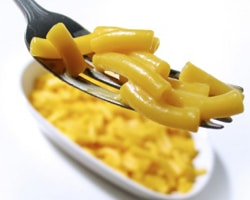
Here are some facts on Additives, Preservatives and Colorings:
- On average, we ingest 2-5 lbs of chemical additives a year
- Over 6,000 chemicals are used in commercially available foods
- Adequate studies on the effects of these chemicals have not been done
|
Common Food Additives |
|
|
Acidic or Alkaline Agents |
|
|
Alginates |
|
|
Anti-caking agents |
|
|
Antimicrobial agents |
|
|
Antioxidants* |
|
|
Aspartame** |
|
|
Coloring*** |
|
|
Curing agents |
|
|
Dough Conditioners |
|
|
Flavorings**** |
|
|
Humectants |
|
|
Leavening agents |
|
|
Propyl Gallate |
|
|
Sequestrants |
|
|
Stabilizers, thickeners |
|
|
Sulfites |
|
* BHA (butylated hydroxyanisole) and BHT (butylated hydroxytoluene)
- These are closely related chemicals (preservatives, antioxidants) added to oil-containing foods in order to prevent oxidation, prolong shelf life;
- Can affect nervous system;
- Possible carcinogens – induced tumors in rats stomachs;
- BHT may convert hormones and oral contraceptives into carcinogens;
- Found in: cereals, instant potato flakes, frozen dinners, baked goods, fruit drinks.
** Aspartame is marketed as NutraSweet, Equal, Spoonful, Canderel, Benevia.
You may find aspartame in:
- Chewing gum, candy
- Diet soft drinks, iced tea
- Yogurt (sugar-free)
- Breath mints
- Gelatin, frozen desserts
- Juices
- Wine coolers
- Over-the-counter drugs
*** Tartrazine (Yellow Dye No. 5) is a coal-tar derivative used to color foods, cosmetics, and other products. Yellow dye No. 5 may be carcinogenic, may cause allergies, asthma, has been linked to ADD/hyperactivity, migraines, thyroid
cancer, lupus
Can be found in:
- Prescription and non-prescription pharmaceutical drugs, aspirin, birth
control pills
- Soft drinks
- Skim milk, butter/margarine
- Orange colored cheeses
- Kraft Dinner
- Orange colored snacks (cheezies, Doritos, etc.)
- Candy, gelatin and puddings
- Ice Cream
- Mountain Dew, artificially colored drinks
- Boxed breakfast cereals
- Shrimp
- Canned fruits and vegetables
- Pastas, breads, cakes, and other baked goods (containing "candied fruit")
- Wasabi
- Alcoholic drinks (sours and some beer!)
- Shampoo, cosmetics, lotions
- Toothpaste
- Vitamins
**** Monosodium Glutamate:
There are many different names/terminology for MSG. Some of them include:
- Isolated protein source
- Autolysed yeast
- Hydrolyzed vegetable protein
- Hydrolyzed yeast
- Vegetable powder
- Natural flavours
- Glutamate
- Caseinate
- Yeast extract
Can be found in: Chinese food; garlic power, seasonings, soups, bouillon cubes, soup stock, anything breaded, Accent (pure MSG), flavored potato chips and seasoned nuts
Splenda is also known as sucralose.
- It is a chlorinated sucrose derivative
- There are independent controlled or long-term human studies conducted on Splenda.
- Pre-approval research shows Splenda shrinks the thymus (up to 40%), and may enlarge the liver & kidneys
- Long-term use may contribute to serious immunological or neurological disorders
Sugar:
Ingredients that end in “ose”
- Brown sugar
- Corn syrup, corn syrup solids
- Dextrose
- Fructose
- Glucose
- Grape juice
- High-fructose corn syrup
- Honey
- Malt syrup
- Maltodextrin
- Mannitol
- Maple syrup
- Molasses
- Raw sugar
- Sorbitol
- Sorghum
- Sucrose
- Turbinado
- Xylitol










